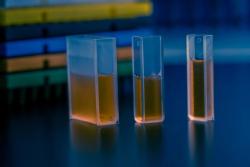
OR WAIT null SECS
- About Us
- Advertise
- Contact Us
- Editorial Info
- Editorial Advisory Board
- Do Not Sell My Personal Information
- Privacy Policy
- Terms and Conditions
© 2025 MJH Life Sciences™ , Pharmaceutical Technology - Pharma News and Development Insights. All rights reserved.
Advancing analytical testing and instrumentation for biopharmaceuticals
Instrument manufacturers and testing service providers are offering improved tools to biologic charaterization.
As biopharmaceutical/pharmaceutical companies increase their development of biologic-based drugs, companies providing analytical instrumentation and laboratory testing goods and services are, in turn, offering improved tools for biologic characterization, biomanufacturing, and related testing.
Chad Baker/Getty Images
In December 2012, Sartorius Stedim Biotech (SSB) expanded its process analytical technology software capabilities by partnering with Umetrics, a provider of multivariate technology, including software for design of experiments (DoE) and multivariate data analysis (MVA). Under the pact, SSB assumes global marketing and distribution of the Umetrics portfolio for the pharmaceutical and biopharmaceutical industries and will integrate Umetrics software programs as private-label products into its own bioprocess portfolio and market these as stand-alone solutions under a dual branding arrangement. The major areas for these software systems are critical process steps, such as cell-culture processes or specific purification steps. MVA enables process parameters to be added in batch trajectories, and DoE software permits these critical process parameters to be identified and quantified.
In January 2013, Waters expanded its biopharmaceutical platform solutions with UNIFI, new ACQUITY ultra-performance liquid chromatography (UPLC) CSH130 C18 and XSelect HPLC CSH130 C18 columns for peptide mapping, and three GlycoWorks kits for glycan labeling and sample preparation. These products further progress routine biotherapeutic analysis, particularly for glycoproteins that require analysis of glycan modifications as well as protein- and peptide-level structural analysis. The biopharmaceutical platform solution brings together UPLC/mass spectrometry (MS) characterization technology with the UNIFI Scientific Information System that was first developed for intact protein mass analysis, peptide mapping, and supporting general bioseparations. The expansion supports a mix of quadrupole time-of-flight (Q-TOF) MS and optical-detection instruments within a networked laboratory workgroup. The newly released Glycan application workflow expands the platform's capabilities to support routine assignment and profiling of released glycans using fluorescence detection. The combination of high-performance UPLC HILIC (hydrophilic interaction liquid chromatography) separations, the company's calibration standards and reagents, and access to Ireland's National Institute for Bioprocessing Research and Training (NIBRT)/Waters' GlycoBase 3+ UPLC glycan unit reference database enables glycan assignments, quantification, and profiling. Developed by Prof. Pauline Rudd's research team at NIBRT, the GlycoBase 3+ database is a repository of glycan chromatographic retention data, expressed in glucose calibration units, and which encompasses sets of glycan structures associated with biotherapeutic glycoproteins.
Also in January 2013, PerkinElmer launched the JANUS BioTx Pro automated workstation for improved process development of proteins. The workstation is designed for high-throughput, small-scale protein purification (of µg to mg proteins) and accommodates multiple chromatography modes (column, tip and batch). It supports commercially available plate and column-based screening tools, such as GE PreDictor plates, PhyNexus PhyTip columns, and Atoll columns. Applications for the workstation include resin-binding studies and conditions screening.
In May 2012, Shimazdu launched an improved Accurate Glycan Analyzer 2 (AGA2), which provides a glycan database and the company's AXIMA Resonance, a MALDI (matrix-assisted laser desorption/ionization)–QIT (quadrupole ion trap)–TOF (time of flight) mass spectrometer. The AXIMA Resonance is coupled to a database containing glycan structural information generated from actual MSn spectra to select precursor peaks up to MS4 . The resulting spectra are interpreted to return the most likely glycan structure. The AGA2 was created from biosynthesized glycans and contains well-defined and characterized, biologically relevant, glycans. It also uses common fluorescence-labeling schemes, including 2-aminopyridine, 2-aminobenzoic acid and 2-aminobenzamide, and other types of fluorescence labeling.
In February 2013, Thermo Fisher Scientific expanded its high-content analysis portfolio with three new solutions in cell biology: the Thermo Scientific ArrayScan XTI High Content Analysis (HCA) Reader, Thermo Scientific CellInsight NXT High Content Screening (HCS) Platform, and the Thermo Scientific X1 upgrade for current ArrayScan VTI customers. Each of these products features a large-format, sensitive CCD (charged-coupled device) camera, the Thermo Scientific HCS Studio software suite, and greater processing capabilities. The Thermo Scientific X1 CCD camera, used for high-content analysis, offers improved sensitivity, increased resolution, and a large field of view.
Thermo Fisher Scientific also introduced the Thermo Scientific Dionex GlycanPac AXH-1 HPLC column, which is designed for simultaneous separation of biologically important glycans based on charge, size, and polarity. The column is designed to separate both labeled and native glycans based on the availability of samples. Native glycan separation allows researchers to eliminate the fluorescent labeling step and increase throughput.
In 2012, Agilent Technologies partnered with Spain's Center for Omic Sciences in mass spectrometry and NMR (nuclear magnetic resonance)-based metabolomics and automation for use in integrated systems biology. The Center for Omic Sciences (COS) was established by the Rovira i Virgili University in collaboration with Spain's Technological Center of Nutrition and Health. COS opened in September 2012 and is equipped with instrumentation from Agilent. The COS is a center of excellence where Agilent will demonstrate integrated biology workflows in genomics, proteomics, transcriptomics, lipidomics, and metabolomics.
In November 2012, Bruker launched METALJET, a bright microfocus X-ray source for structural biology applications. METALJET is a source option for D8 VENTURET protein crystallography systems and for NANOSTAR Small Angle X-ray Scattering (SAXS) systems. The METALJET source for Bruker structural biology systems was developed in collaboration with Excillum AB and Incoatec GmbH for use in protein crystallography and SAXS applications.



